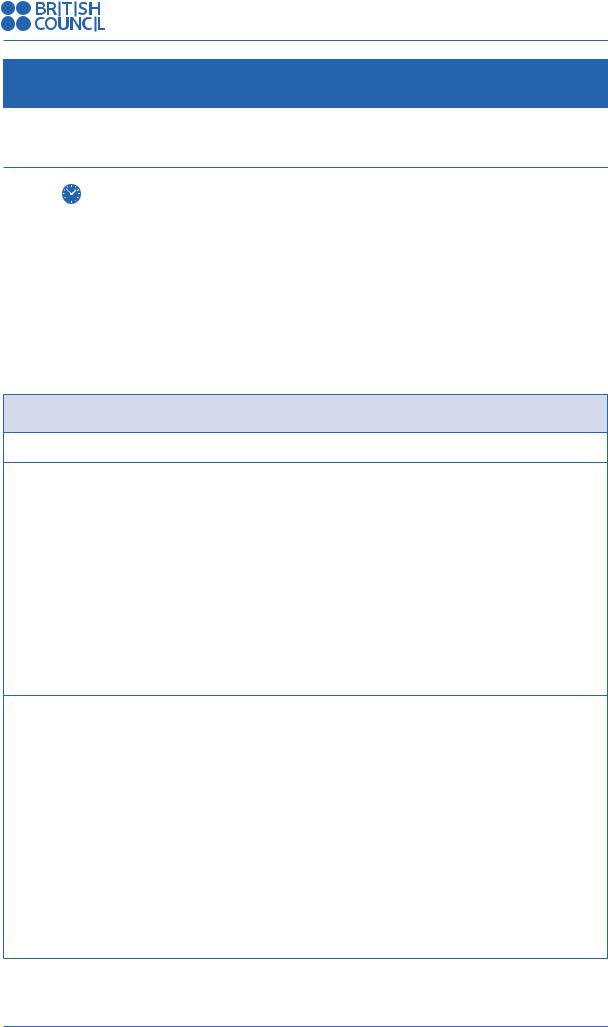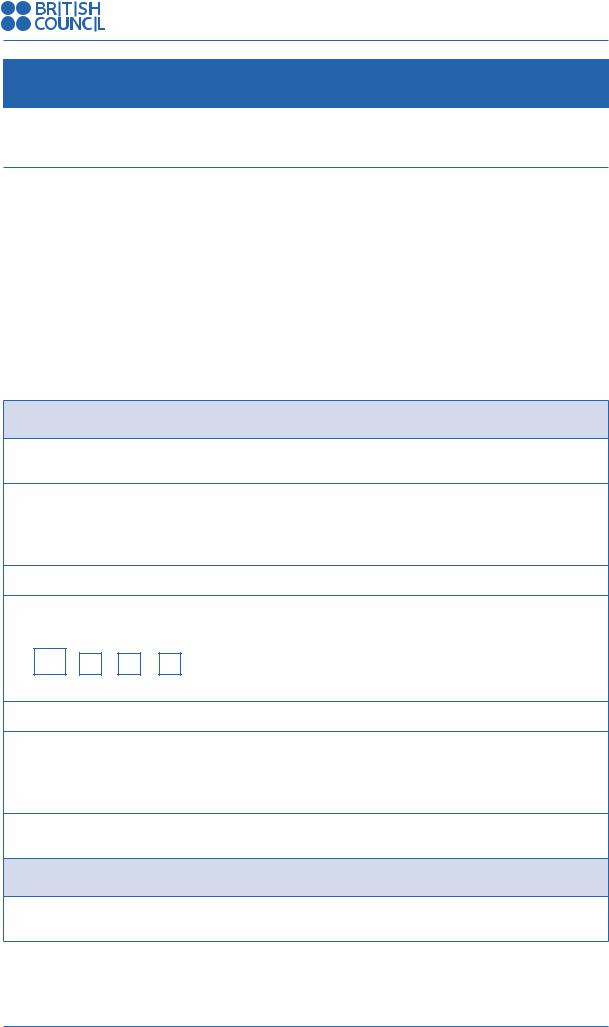
B369-Young-Learners-Activity-Book_v10
.pdf
TeachingEnglish Young Learners Activity Book
Activities
Notes
Low level children need a lot of support to produce texts. This activity scaffolds them in doing so. The texts can then be put on the walls of the classroom, or made into a class book to show to visitors.
Alternatives
•At the role play stage, the teacher (or another child) can interview the tourist. If a child takes on this role, they can be given interview questions: Can you tell me where you have been? Which place did you like best? Why? And so on. Interviews could also be recorded.
•Make a diary activity. After stage 3, the children fill in a diary, choosing the sites they wish to visit. Then they share the information with their partner.
I will visit /see / go to…
Sunday
Monday
Tuesday
Wednesday
Thursday
Friday
No resources?
Elicit places of interest from the children rather than showing them pictures. Ask the children to draw a place of interest. The other children can guess where it is. Draw a rough map on the board and the children can write their texts directly on to the board.
© British Council 2012 |
89 |
|

TeachingEnglish Young Learners Activity Book
Activities
Activity 42: Traffic lights
Ludmilla Gerasimova – Russia
Age: 4–6  Maximum 40 minutes Large classes? Yes Mixed level? Yes
Maximum 40 minutes Large classes? Yes Mixed level? Yes
Materials: A piece of paper and a red, yellow and green crayon for each child. Organisation: Individual, whole class.
Aim: To revise colours and simple verbs, to get children to pay attention.
Description: Children make a set of traffic lights using the paper and coloured crayons. They then show they understand the colours and basic commands.
Preparation: A piece of paper for each child and enough red, orange and green coloured pencils/crayons for the children to share.
Procedure
1.Distribute the pieces of paper and crayons. Show the children how to fold the paper in half length ways. The top half is the cover and the bottom half is the base.
2.Show the children how to draw three circles on the base from top to bottom.
3.Ask the children to colour in the three circles: the top circle is red, the middle circle is yellow and the bottom circle is green, just like traffic lights.
4.Ask the children to point to the coloured circles as you say the colours out loud.
5.Show the children how to cut the cover into three flaps, so that each flap covers one circle.
6.Call out ‘stop!’ and the children show the red circle. Call out ‘get ready’ and the children show the yellow circle. Call out ‘go’ and the children show the green circle. Practise this a few times.
7.Put the children into groups of three to five. The children take it in turns to shout out ‘stop’, ‘get ready’ and ‘go’ while the other children show the correct colour.
8.Now teach them the actions. For ‘stop’ the children must sit on the floor; for ‘get ready’ the children must look at the teacher quietly. For ‘go’ the children must do the activity, running, skipping, reading, playing and so on.
9.Practise the actions with the children until they respond automatically to the commands.
90 |
© British Council 2012 |
|

TeachingEnglish Young Learners Activity Book
Activities
Notes
This is a very good activity to teach to children at the beginning of a course. Once they know the commands, it is then very easy to get them to stop an activity quickly or to start an activity
quickly. You can either shout the commands, or you can show them the colour of the traffic lights.
Young learners in particular cannot sit for long periods of time and easily get bored. This activity allows you to introduce a quick energetic activity into the lesson (such as skipping or running) which you can easily control.
Alternatives
•The children can take it in turns to be the teacher using their own traffic lights to control the class.
•If you are doing group work, one child can be in charge and can control the group using the traffic lights they have made.
•Rather than traffic lights you can introduce other cues, particularly with older learners. For example, you can write ‘ed’ in a splash box in the corner of the
board. When children forget to use the past tense, you can point to the cue, rather than reminding them orally each time. You can do the same for the articles, ‘a’ and ‘the’ and other easily forgotten things, such as ‘s’.
No resources?
ed
If you do not have paper and coloured crayons for all the children, make one set yourself and teach the children the actions.
You could draw the traffic lights on the board at the beginning of class and then point to the colour for the action you would like the children to perform.
Acknowledgments
Ludmilla learnt a version of this activity on a Teaching Young Learners course at the Language Link in Moscow.
© British Council 2012 |
91 |
|

TeachingEnglish Young Learners Activity Book
Activities
Activity 43: Vocabulary chart
Patrycja Łuczak – Poland
Age: All |
10–15 minutes Large classes? Yes Mixed level? Yes |
Materials: Blackboard/whiteboard, chalk or board pens. Organisation: Group work, whole class.
Aim: To revise vocabulary.
Description: This activity involves a team competition, which can be interesting and motivating for children as well as encouraging co-operation. Children revise vocabulary by finding words that start with a given letter. Each letter has a score and the children in teams compete to see which team can get the highest score.
Procedure
1.Decide on an area of vocabulary that you wish to revise, for example, jobs.
2.Draw a chart on the board with 12 squares, numbering each square as illustrated below:
1 |
2 |
3 |
4 |
|
|
|
|
5 |
6 |
7 |
8 |
|
|
|
|
9 |
10 |
11 |
12 |
|
|
|
|
3.Ask the children to give you some letters of the alphabet to write in the squares, for example:
1 |
2 |
3 |
4 |
D |
O |
A |
B |
|
|
|
|
5 |
6 |
7 |
8 |
K |
E |
I |
N |
|
|
|
|
9 |
10 |
11 |
12 |
J |
W |
G |
Z |
|
|
|
|
92 |
© British Council 2012 |
|

TeachingEnglish Young Learners Activity Book
Activities
4.Divide the children into teams of five or six. Each team in turn has to give the name of a job beginning with one of the letters in the chart. If the word is correct, the teacher writes it on the board and the team scores the number of points given in the square. For example, if a team says the job builder, they get four points, while for journalist they get 9 points. The team with the highest score wins.
Notes
The chart can have any number of squares you like. You could write the letters in the order the children give them, or write the more difficult letters in the squares with the higher scores.
You can allow each letter to be used only once, or you can allow each letter to be used as many times as you choose.
Alternatives:
•Instead of asking teams to call out words in turn, they can be told to write down as many words as they can beginning with the letters within a time limit of, for example, five minutes.
•You can ask the team to spell the word for you to write on the board, deducting points for incorrect spelling.
•Teachers of young learners in Japan suggested the following two activities for large classes.
a.Divide the children into teams, and give them time to decide on a job for each square. Then play the game.
b.Divide the children into teams. Teams must race to find a word for each letter. The first team to have a word for each letter wins.
No resources?
This activity does not require any particular resources.
This activity comes from a methodology course held at the Richard Language College, Bournemouth, UK.
© British Council 2012 |
93 |
|

TeachingEnglish Young Learners Activity Book
Activities
Activity 44: Vocabulary challenge
Laurie Thain – Canada
Age: 6-10  At least 20 minutes Large classes? No Mixed level? Yes
At least 20 minutes Large classes? No Mixed level? Yes
Materials: Flashcards. Organisation: Whole class activity. Aim: To learn new vocabulary.
Description: In this game the class have to guess what is on a card chosen by one of the children.
Preparation: You will need to make flashcards of the new vocabulary items (we use furniture here). There should be one card for each child in the class.
Procedure
1.Ask the children to sit in a circle. Teach the children the words on the flashcards. There are lots of ways you can do this. We suggest the following: show each card and say the word. Children repeat. Show the cards again in a different order and ask the children to say the correct word. Help them if necessary. Then give each child a card. The children show the cards one-by-one and the class says the word. The children can then put cards face down in front of them and the teacher asks, ‘What card does Mary have/has Mary got?’ and the children have to remember. If they are right, the card is turned face up.
2.When all the cards have been learnt, you can play the game. Choose one leader and one helper. The helper gathers all the cards and the leader chooses one which they put face down on the floor.
The helper holds the remaining flashcards. The children take turns asking the leader questions. For example, if the vocabulary set is domestic animals, the children might ask,
‘Do you have the chair?’ The leader answers, ‘Yes I do’ or ‘No I don’t’.
If ‘Yes’, the lucky guesser becomes the leader and chooses a new card to turn face down and there is a new helper assigned. If ‘No’, the helper turns up the ‘cat’ so all can see it. Then children take it in turns to ask a question until someone guesses correctly and becomes the leader.
Notes
You can play lots of rounds of this game or just a few – it is up to you! It is also a really useful activity for revising vocabulary previously taught.
94 |
© British Council 2012 |
|

TeachingEnglish Young Learners Activity Book
Activities
Alternatives
•The teacher can be the leader. If a child guesses the card correctly, they keep it. At the end of the game, when all the cards have been collected, the children take it in turns to say what they have, for example, ‘I have a chair, a table and a cupboard’.
•Hatice Elif Kalaycioglu (Turkey) suggests the following alternative: instead of sitting in a circle, the children stand in a circle. The teacher plays some music and the children walk round the cards. When the music stops, the teacher calls out the item of vocabulary. The children have to point to the correct picture card. If you want to make this into a competition, the last child to point and any children who points to the wrong card can be ‘out’, until only one child remains. She also suggests putting the pictures on the board. The children can be divided into two teams, A and B. The teacher calls out one item of vocabulary and the first member of the team has to go to the board and either take the correct picture or point at it. The first child to do so wins the point.
•The same activities can be used to practise sound/spelling associations. Instead of pictures, write the words on the cards, or use a mixture of picture and word cards. The children have to collect both the correct picture and word cards.
•Ask the children to cut pictures out of magazines, newspapers etc and stick them on card (laminate them if you can). Over time, you can build up a class collection of picture cards that can be used for a number of different activities.
No resources?
Flashcards do not have to be of professional quality. Basic drawings on scrap paper are fine.
© British Council 2012 |
95 |
|

TeachingEnglish Young Learners Activity Book
Activities
Activity 45: Walking the words
Mustafa Mohamed El sayed Ahmed El shamy – Egypt
Age: 4 –12  30 minutes Large classes? Yes Mixed level? Yes
30 minutes Large classes? Yes Mixed level? Yes
Materials: Board and pen/chalk
Organisation: Whole class
Aim: To learn and practise stress patterns in difficult words.
Description: Children practise the stress patterns in difficult or long words by walking the word (small, light steps for unstressed syllables; long, energetic steps for stressed syllables).
Preparation: There is no preparation needed for this activity, but you should decide before the lesson which words you are going to practise.
Procedure
1.Tell the children they are going to learn an interesting way to remember stress patterns in long or difficult words.
2.Choose a long or difficult word like Alligator. Ask the children to watch you. Stand in front of the class and walk the word by taking a short, light step for unstressed syllables, and
a long, energetic step for stressed syllables. For information, you should take one long, energetic step and then three short, light steps. As you walk, say the word.
3.Demonstrate with a few more words.
4.Write some long or difficult words on the board and then elicit the stress patterns from the children, perhaps like this (the ‘a’ has the biggest box as it is the stressed syllable):
Al li ga tor
5.Put the children into pairs or groups.
6.Tell the children they will take it in turn to read the words off the board or walk the word. In a pair, child A first of all chooses a word from the list on the board, and child B walks it, saying the word out loud. Child A checks if child B has the stress pattern correct by looking at the stress pattern on the board. Then they swap around.
7.At the end of the lesson, the children can record the words and their stress patterns in their vocabulary note books.
Notes
Choose words that the children know the meaning of so that they can concentrate on the pronunciation only.
96 |
© British Council 2012 |
|

TeachingEnglish Young Learners Activity Book
Activities
Alternatives
•This activity can be done in groups following the same procedure.
•As the children get good at the activity, you can ask them to step sentences. This is particularly good for helping children to understand how stress changes in longer stretches of talk.
•With younger children use simpler words.
•The activity can be used to learn/practise the stress patterns of the names of countries, using the country’s flag to mark the stress.
•Chiyuki Yanase (Japan) suggests another variation: the children can bend their knees for unstressed syllables and jump for stressed syllables. So, for example, for the word banana, they would bend knees, jump and bend knees.
•Teachers of young learners in Japan suggested other entertaining ways to indicate the stress patterns of words. These include, for example, ‘duck hands’ where children put their four fingers to their thumb in imitation of a duck’s beak. They open wide for stressed syllables and only a little for unstressed syllables, waving arms up and down, and, of course, clapping.
No resources?
You only need a board and pen/chalk for this activity.
© British Council 2012 |
97 |
|

TeachingEnglish Young Learners Activity Book
Activities
Activity 46: We are different
Alma Balniene – Lithuania
Age: All ages |
Maximum 15 minutes Large classes? Yes Mixed level? Yes |
Materials: None Organisation: Whole class
Aim: To practise listening and responding personally to questions and statements.
Description: The children stand in a line. The teacher asks questions or reads out statements. Children stay on the line or move away from it depending on whether they agree, disagree or cannot decide.
Preparation: You will need to prepare the questions or statements to read out.
Procedure
1.Ask the children to stand in a line.
2.Tell the children you are going to ask questions or make statements. Explain that the children have three options:
a.They should take a step forward if the answer to a question is yes, or if they agree with a statement.
b.They should take a step backwards if the answer to a question is no, or if they disagree with the statement.
c.They should stay in the same place if they do not know the answer to the question or if they cannot decide if they agree with the statement.
3.Read out a statement or question, for example, ‘Do you like ice cream?’ The children step forward, backwards or stay in one place, depending on their answers.
4.Read out another statement/question, for example, ‘I have a pet’. The children step forward or backwards or remain in the same place depending on what is true.
5.Continue until you run out of questions or until the children can no longer step backwards or forwards.
Notes
This activity does not require that the children speak, so it is not stressful for them.
98 |
© British Council 2012 |
|
